2010 Civil War Travelogue
Welcome to my 2010 Travelogue page, Part 2. Go to Part 1. Go to Part 3. Go to Part 4. Go to Part 5.
| Here is a reminder about the reason I write these pages the way I do. They record my experiences and impressions of Civil War trips primarily for my future use. Thus, they sometimes make assumptions about things I already know and focus on insights that I receive. They are not general-purpose descriptions for people unfamiliar with the Civil War, although I do link to various Wikipedia articles throughout. Apologies about the quality of interior photographs—I don't take fancy cameras with big flashes to these events. If you would like to be notified of new travelogues, connect to me via Facebook. |
Civil War Preservation Trust Annual Conference, Lexington, Kentucky — June 3–6, 2010
Wednesday, June 2
I had a great time in Lexington, Kentucky, for another annual conference of the Civil War Preservation Trust. I had a good set of flights through Chicago and arrived Wednesday afternoon to check into the Hilton Downtown Lexington, which is a very nice hotel. It seems rather remarkable that such a visibly small city is able to support two very large high-rise hotels—Hilton and Hyatt Regency. Before registration I walked around downtown a bit and did not manage to run into anything interesting, except statues of John C. Breckinridge and John Hunt Morgan.
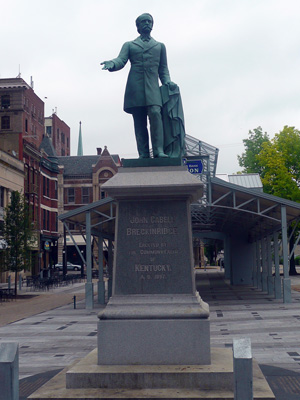 |
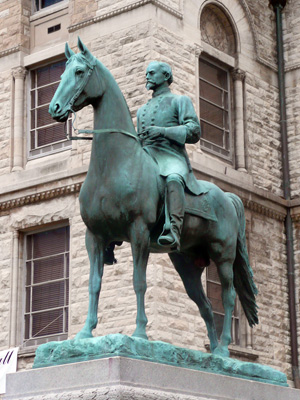 |
| John C. Breckinridge | John Hunt Morgan |
Registration was at 6 PM and I got a bag full of goodies, including a commemorative map of the Battle of Shiloh (??— I thought this conference was about Kentucky), an unusual coffee mug commemorating the Battle of Richmond, a pad of CWPT paper shaped like a mouse pad, and a CD from an artist named Kyle Thompson. The latter included vocal performances at a number of battlefields. (I had coincidentally been joking with people on the elevator that instead of the jazzy background music they played in the elevator car that they should have come up with some Civil War music for us, but I hope they do not take that suggestion using this CD.) The CWPT staff is really well organized and they had individual schedules made up for all of the optional touring that I will be doing this weekend.
There was a small reception with sandwiches and a hosted bar. The group responsible for preserving the Franklin Battlefield sponsored a bourbon tasting, but I was told that the local ABC objected to direct tasting, so it was mixed into some sort of a punch concoction, which entirely defeats the purpose of ingesting a nice bourbon, in my humble opinion. I found a few people I knew to talk with, including Eric Jacobson of Franklin and David Duncan of the CWPT. Eric amused me by revealing that he was scheduled to speak tomorrow but he did not know the subject of the speech—there is a confident public speaker! David told me that he expected 275 people at the conference, which is about average for a Western Theater conference, but there were certainly not more than 50 people at the reception.
One bit of news was circulated today: next year's annual conference will be To the Gates of Washington: The Battles of Manassas, May 19–22, 2011. I will probably consider attending that if the schedule works.
Thursday
At the breakfast buffet early on Thursday, I had the pleasure of meeting a guy I had been communicating with quite a lot, Rob Shenk, the CWPT director of Web services. He has made enormous improvements to their Web presence. Rob and I have collaborated in a very minor way on some Wikipedia articles.
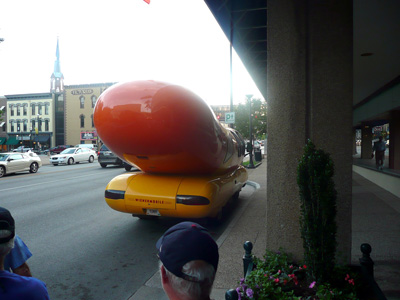 |
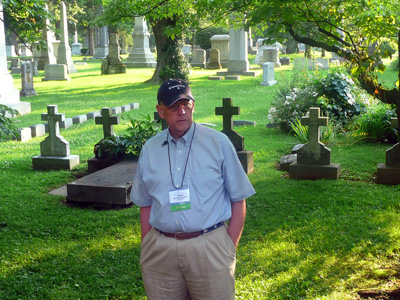 |
| Business end of the WeinerMobile! | Kent Masterson Brown in Lexington Cemetery |
This morning the Color Bearers went off on bus tours by themselves while the remaining conference attendees stayed in the hotel to hear lectures for the morning. (The Color Bearers are the more significant annual donors to the CWPT and it looks like there are about 150 at the conference.) Our bus departure area was shared by an Oscar Meyer WeinerMobile! Boy, was I tempted to jump on board that one! We started at Lexington Cemetery with Kent Masterson Brown. Kent, whose reputation I know primarily as the "retreat from Gettysburg" guy, is a longtime Kentucky resident and is considered "the" Kentucky guy. This was a fascinating visit, with more detail than I have ever encountered in a cemetery. First, the cemetery is simply beautiful, on rolling green hills with lots of giant shade trees. It was one of the first of the "rural cemeteries" built in the 1850s, which were designed to bring city residents into a peaceful setting while visiting the dead. It is the resting place of five Confederate generals and one United States major general. Kent is like a walking encyclopedia of genealogical information and he was able to take us through the family trees of all the prominent Kentucky families, which are quite intertwined, and which contributed men to both sides of the war. He remarked that Kentucky has no family trees, only vines. We visited the family plots that included Randall Lee Gibson, the Todd family— the relatives of Mary Todd Lincoln, which Kent described as the most interesting plot in America—the Hunt-Morgan family, which included John Hunt Morgan and Basil W. Duke, and the Breckinridge family, including John Cabell Breckinridge. We saw the national cemetery, which was populated by Union occupation troops, and the generic Confederate section. The only significant Union guy was Gordon Granger, who is like the secondary hero of the Battle of Chickamauga (after George H. Thomas), and who I was surprised to find out was born in Wayne County, New York, where my wife grew up. In the cemetery, I suggested to Jim Lighthizer that he use this opportunity to promote the CWPT estate planning activities, which he thought was humorous, but declined to follow. (I later asked Melissa whether there was a Color Bearer section of the cemetery and she said no, although it might be a reasonable marketing idea to arrange something like that in a famous cemetery like this one.)
The next stop was Camp Nelson, which I had visited previously (see my 2007 Perryville report), so there is not a lot to say again. It was a giant Union supply depot built in 1863 by Ambrose Burnside when he commanded the Army of the Ohio and is notable as the third-largest training center for US Colored Troops. We split up into three groups and rotated for short visits to: (1) Steve McBride, still the resident archaeologist, who showed us some digging projects that are trying to determine the exact location and nature of the jail and stockade; (2) the White House, the 1850s building that was used as an office by the senior officers at the camp (and which I had not visited previously); and (3) the museum, which has some interesting exhibits showing how the soldiers and the civilian refugees lived. These visits ran a little late, so we raced back to the hotel, so much so that our bus driver was pulled over by the Nicholson police for speeding! She got a warning, but also a lot of jokes on the way back.
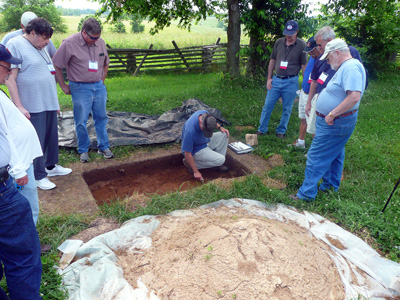 |
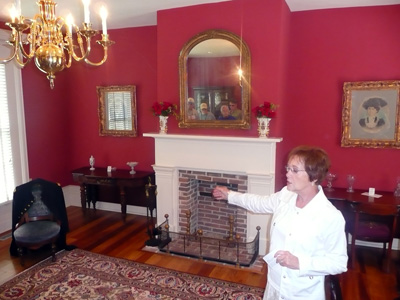 |
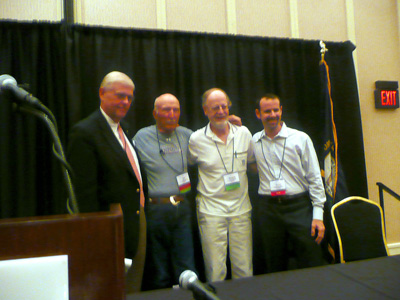 |
| Archeology at Camp Nelson's jail site | Camp Nelson's White House | Afternoon panel: Kent, Ed, Richard, Garry |
After a nice buffet lunch, we had an afternoon of presentations. Kent Brown gave an excellent talk about the politics of Kentucky during the war. He said that when he was a young boy, he was under the impression that Kentucky was a Confederate state because there was an overwhelming number of Confederate monuments and sentiments at every turn. He described how most of the population of Kentucky originated in Virginia but also how many native Kentuckians migrated to Ohio, Indiana, and Illinois. Kentucky was the hemp capital of the world and virtually all of the ropes used by the U.S. Navy came from there. At the start of the Civil War, Kentucky was deadlocked between a pro-Confederate governor and a mildly pro-Union legislature. However, in the summer of 1861, local elections were held and the legislature became about 10 to 1 pro-Union. They passed a law that it was a felony to be a Confederate. The state was virtually 100% against the Emancipation Proclamation and passed a resolution attempting to nullify it. Their primary concern was the passage of numerous runaway slaves from Confederate territories burdening their state. Despite remaining in the Union, Kentucky had a military governor and was essentially occupied during the war. They became so angry at the oppressiveness, by the end of 1864 they were at a noticeable risk of seceding. George B. McClellan was the big winner in Kentucky in the presidential election of 1864. Shortly thereafter, the Democratic Party came to life for the first time in the state—it had formally been Whig, following its native son, Henry Clay—and it was not until Eisenhower that the Democrats lost any elections. Kent went through a list of some of the prominent Confederates who were elected to state government after the war. The second postbellum governor was a doctor named Luke Blackburn who achieved some notoriety during the war by planning to infect northern cities with yellow fever. In all of Kentucky, only one county (Fleming) has a Union monument. The state did not ratify the 14th amendment until 1976!
Next was a panel discussion hosted by Garry Adelman, with Ed Bearss, Kent Brown, and Richard McMurry. As usual, I did not attempt to record all of the questions and answers, but there were some interesting ones. In a discussion of the command failures in the Western theater, Ed cited Lucius Northrop as a key problem, the commissary general who Jefferson Davis thought was brilliant, but Ed judged as an idiot (and was the first person that Robert E. Lee fired after he became general in chief in 1865). Kent said that Braxton Bragg deserved some credit for being able to supply his Army of Tennessee over the immense area in which they operated. Ed got a question about A.P. Hill's gonorrhea and we got to hear some clinical details about the ailment and that soldiers and Marines called the condition "Old Joe." We also learned that Ed himself has never had gonorrhea, but he has had kidney stones. Ed believes that James Ledlie (of Crater drunkenness fame) was the overall worst division commander in the Union Army. Kent gave a rather contrarian opinion of sympathy to Leonidas Polk for his actions in violating Kentucky's neutrality to seize Columbus. Almost all historians say this was an enormous blunder, but Kent cited the formation of numerous Home Guard units within the state and the startup of Union recruiting at Camp Dick Robinson as indicators that state neutrality was essentially lost and Polk had no real alternative. Richard challenged this and said that the recruiting was being done by Kentuckians and that Camp Robinson was little more than a hunting club. (I am pretty sure that his tongue was in his cheek when he made this remark.) Ed revealed that Alexander McCook's nickname at West Point was Chucklehead. He also said that Perryville and Antietam, three weeks apart, represented the real military high-water mark of the Confederacy.
We adjourned to the side room where an enormous collection of Civil War books was on sale and there were little booths from a variety of preservation organizations. I ran into Len Riedel of the Blue and Gray Education Society, who was promoting Ed Bearss's new book. In the evening, the Color Bearers had a nice reception and I actually got to talk about Wikipedia with a number of people. I gave some suggestions about social media to Rob Shenk and will see if future CWPT offerings take advantage of my loopy ideas. At a dinner for the Color Bearers, Garry Adelman gave a PowerPoint presentation on "East Coast Then and Now," which showed period photographs accompanied by their modern equivalent views. Garry is always humorous and he had a number of interesting photographs with himself mimicking historic poses. Jim Lighthizer gave an upbeat talk about the status of the organization. I am not certain which of the financial results and goals that he described were actually on the public record, so I will not repeat them here, but they encouraged me about the future battlefield preservation. The evening concluded with a brief presentation about John Breckinridge at the Battle of New Market, given by a representative of the Shenandoah Valley Battlefield Foundation, and a dessert reception sponsored by the same.
Friday
The major battle in this neck of the woods was Perryville, but since I had experienced an in-depth look at Perryville as recently as 2007, I decided to focus on a couple of other battles this week. Today was Mill Springs, the first Union victory in the war, where on January 19, 1862, George H. Thomas defeated a force of equal size under George B. Crittenden and began the unraveling of the Confederate Kentucky defense line. It was about a 90-minute drive from Lexington to reach Nancy, Kentucky, and we were engaged most of the bus ride by background explanations from our historian, Richard McMurray. Our first stop was at the visitor center, which impressed me as being rather large for a battlefield this small. We met Bill Neikirk, the president of the battlefield preservation association, who introduced us to an overview video and guided us around most of the rest of the day. Bill told an unusual story: no one in the local area was really familiar with the battle until someone from the CWPT (or its predecessor organization, I'm not clear about that) showed up and urged them to start preserving land. Although he did not know very much about the battle, he was elected president of the new association, and remains in that position—president for life, he says. (I hope he does better work than Hugo Chavez.)
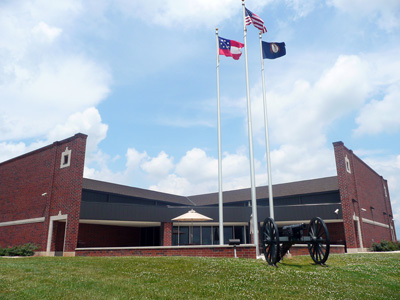 |
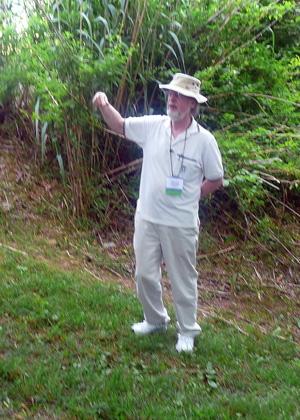 |
Mill Springs Visitor Center—perhaps |
Richard McMurray at Timmy's Branch |
We started our visit by driving to Timmy's Branch, where the first contact was made between the Rebels and the 1st Kentucky (US) Cavalry. Richard made an interesting observation. Both sides had roughly 4,000 men each for this battle and in fact the Confederates were rarely outnumbered (at least by much) in Western theater battles. So Lost Causers cannot argue that those critical battles were lost to overwhelming Union manpower. We drove to the center of the battlefield where the "Zollie Tree" was located. (The tree, which supposedly marks the spot where Brig. Gen. Felix Zollicoffer was killed, was destroyed by lightning in 1995 and the visitor center sells a variety of souvenirs made out of wood from the tree.) I was impressed by the terrain in this area, and the ravine that the Confederate soldiers had to climb to attack the Union line was pretty daunting. Bill guided us on the loop trail and described some of the archaeological studies that are going on to determine what really happened, based on locations of bullets and other artifacts. I found out that there are errors in the CWPT map of the battlefield, which I carried over to my Wikipedia map. Bill arranged to send me some more accurate, detailed maps that he had available at the visitor center, and I will be updating the Wikipedia map next week. We returned to the visitor center and had a delicious barbecue lunch and visited the museum, which was modest but quite informative.
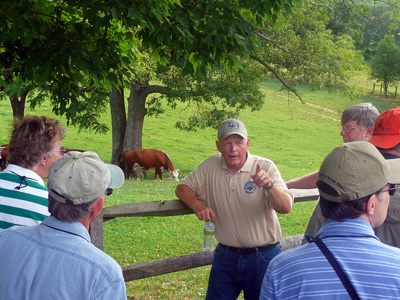 |
 |
| Bill Neikirk on the Mill Springs loop trail | Looking up the ravine to the Union position |
After lunch we drove to the area in which the original Confederate fortified encampment was located. (With the approach of the Union force under Thomas, Zollicoffer decided to leave his somewhat secure location and attack the enemy in the open. Not a great move.) Stop number 7 on the driving tour is where the center of the earthworks on the northern end of the Confederate camp was located, but we really could not see anything and did not get out of the bus because there is a danger of snakes and ticks in the overgrown area. Instead, we drove down to the Cumberland River, across which the Confederates escaped after the battle, employing a small sternwheeler steamboat sent over by Albert Sidney Johnston, the Noble Ellis. Today, the river is part of Lake Cumberland and the crossing point is very considerably wider. (Bill asserts that Lake Cumberland has a shoreline longer than the coast of Florida!) We took a tiny boat that retains the Noble Ellis name and ferried over people 15 at the time. On the southern shore we climbed up a long and steep hill to visit the mill at Mill Springs. This was a location originally scouted out by Daniel Boone, supposedly. The mill was built in 1817, although it had a big upgrade by the U.S. Army Corps of Engineers in 1908 to add a steel waterwheel, which is claimed to be the largest in the world. The operator of the mill gave us a tour, but the machinery only operates as a demonstration on Saturdays. Someone asked him about rodent problems and he said that the owners used to employ snakes for this—cats were too messy! We climbed up the rest of the hill and visited a house at the top built by the mill owner, now called the Brown-Lanier House. It served as a headquarters and hospital after the battle. We started back to the hotel, which by this time was a two-hour drive, and we had an excellent time at the front of the bus trying to stump each other with Civil War trivia questions. Garry Adelman offered the most difficult question: which division commander at the battle of Gettysburg had the greatest age difference with an elder brigade commander reporting to him?
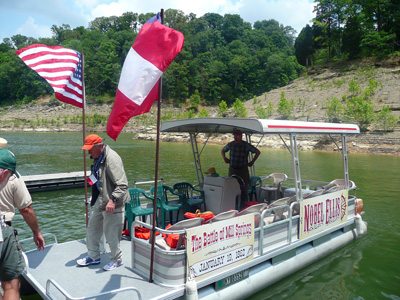 |
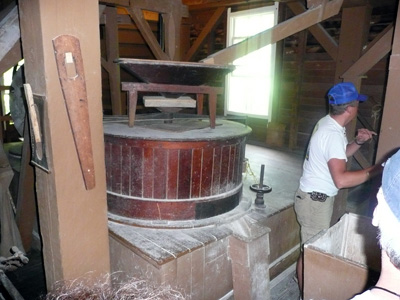 |
 |
| The Noble Ellis reborn on the Cumberland River | Mill at Mill Springs | The world's largest waterwheel? |
By the time we reached the hotel, we had only about 40 minutes to freshen up before an evening excursion to Frankfort, the state capital, about 30 miles away. Unfortunately, a series of logistical misfortunes plagued us all night. (Now we know what Robert E. Lee must have felt like during the Appomattox Campaign.) First, a giant high school graduation in Lexington snarled traffic and the buses were a half hour late picking us up. Then, a critical street in Frankfurt was closed for a carnival and the police sent us on big detour to reach the Kentucky Historical Society, putting us an hour late for dinner. The dinner was really excellent and I chose to sit outside in the balmy evening air. Those who chose inside the air-conditioned building were serenaded by Civil War musicians. We had a relatively short time to visit the museum at the Society, which did not have a lot of Civil War content, but had a number of interesting exhibitions. One Civil War item that they did have on display was a very unusual 25-barrel gun mounted on a carriage.
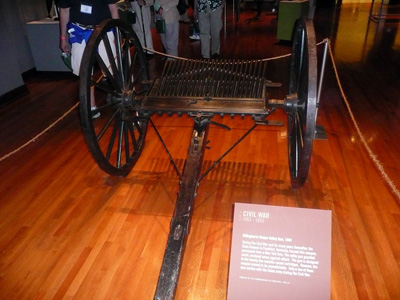 |
| 25-barrel gun at Kentucky Historical Center |
Since we were really late, our organizers did not think we could visit all three of the scheduled sites following dinner, so we were asked to designate which single site we wanted to visit. The answer (for my bus, anyway) was Fort Hill, which overlooks the city. Once again street closures caused us to expend a lot of driving and before we even got to the top, we received word that the park employees got sick of waiting for us and left. None of the ladies guiding us knew anything about the fort, and it would have been almost in the dark anyway. Therefore, we had to vote on an alternative destination, and we chose the Old State Capitol. After more driving in circles, we reached the historic spot, which was abandoned for legislative purposes in 1909. We saw the desks of the senators and legislators and admired a number of the really large portraits of historic figures that decorate the chambers. Outside was the highlight of the visit, however. There is a little plaque on the sidewalk that says "William Goebel fell here" with a date of 1900. Well, he did not just trip and fall, but was assassinated on that spot, having spent a grand total of two days as governor. He also rates a statue in front. We got back to the hotel about 10:30 PM and I was pretty sleepy after a long day. We were blessed by really excellent weather almost all day, although we heard from the folks who visited Perryville that they were caught in a tremendous thunderstorm with intermittent heavy wind, rain, and hail!
Saturday
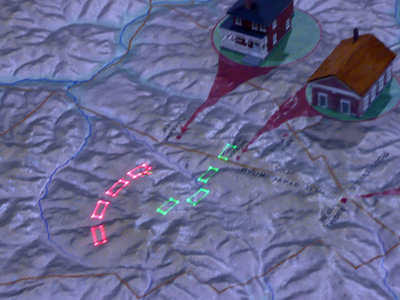 |
| Laser display at the Rogers House, Richmond |
Today turned out to be another decent day, weatherwise—pretty warm with occasional breezes, and no rain. We visited the site of the Battle of Richmond, courtesy of Phil Seyfrit, the director of the battlefield association. As he told us about ten times, all of the preservation and restoration work that we saw during the day was the fruit of only eight years of labor. Pretty impressive to acquire multiple tracts of land and outfit two visitor centers in that time. He was a humorous guy who wore the uniform of the Union colonel for the day. (He told us that he had a Confederate uniform, but that it was too hot.) We drove 22 miles to Richmond and started out at the Rogers House, an 1841 mansion that was restored to be the main visitor center. The exhibits were very nicely done, with a lot of well-designed graphics. They had a visual aid of the battle I had never experienced before: a three-dimensional terrain map over which a laser projector was mounted in the ceiling, and as the narration described troop movements, the laser painted moving troop boxes and arrows to accompany it. It was very effective and everyone complimented it. Phil revealed that it cost $90,000 from a company named Lumalore. (Perhaps that is a business I should come out of retirement and enter. It sounds pretty lucrative.) They also had a really cute video called "The Civil War in Four Minutes," which everyone complimented as well. I found it on YouTube here.
Next we drove south to Big Hill, where a battle/skirmish occurred on August 23 as the Confederates were approaching Richmond. Col. John Scott's dismounted cavalry cleared the road to Richmond. We were met at the visitor center by Bob Moody, who received a round of applause when Phil revealed that he had put up the deed for his farm as collateral to acquire the battlefield land. This terrain, in what is called the Knobs region, was dramatically different from the Blue Grass region of Lexington and Richmond, requiring a steep climb up a highway blasted out of dramatic limestone cliffs. We had to imagine the Confederates trying to navigate this area prior to the modern highway. During the retreat from Perryville, Patrick Cleburne was ordered to spike his cannons, but he refused and urged his men to carry them, piece by piece, over the mountains. The visitor center was used as a hospital after the battle, although there were only about 50 casualties. The ladies there treated us to a large spread of homemade cakes, including some fabulously delicious bourbon cake. I ate way too much of it.
 |
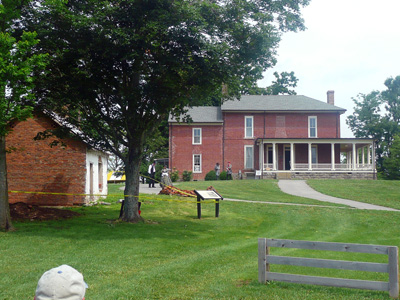 |
| Phil Seyfrit and Bob Moody | Pleasant View Farm |
We drove north alongside the Old State Road that was used by the Confederates and pulled into Blue Grass Army Depot, where we were met by Kevin Bennett, the base attorney, but also the author of the comprehensive article about the battle of Richmond in Blue and Gray Magazine. If it were not for Kevin, it is doubtful we could have been admitted to the base, which had all of its security barriers up. In addition to conventional weapons, there are still a number of chemical weapons stored there. We got to visit an area that supposedly Ed Bearss himself has never visited! There are about 400 acres from the core battlefield owned by the federal government here, but they have promised to turn it over to the battlefield association after all of the chemical weapons have been decommissioned. That won't happen until the end of the decade, but in the meantime the battlefield land is in a pristine state. All of this area consists of gently rolling hills, only lightly wooded. (This is the kind of terrain that we used to call "good tank country" when I was in the Army.)
We drove to the second visitor center, which is called Pleasant View Farm, the 1820 Barnett mansion. This is the location of the most important fighting in the first phase of the battle. They have a looping trail of .6 miles that is very nicely interpreted with wayside signs. I walked out to see the ravine that is called the Churchill Draw, which the Confederates of Col. Thomas J. Churchill's brigade used to sneak up on the Union right flank. We were served lunch under a large tent by volunteers, including eighth-graders dressed in period costumes, all of whom were efficient and very polite. (I don't know that they have any children like this in California. They spoke clearly and there were no piercings, no attitudes, and no cellphone texting!) The mayors of Richmond and Berea dropped by to say hello.
After the Union troops were defeated in a double envelopment in the first phase of the battle, they pulled back to the second phase, which centered around Mount Zion Church. We skirted around a golf course and housing development, which is the only real impediment to a fully preserved battlefield in this sector, and were hosted in the church by Ed Ford, who told us stories about how it was used as a hospital. We saw the pews where a door was laid over the top to act as an operating table. All of the Union medical supplies were lost and the doctors had to operate without medicine or anesthesia. It was 96° outside and I can't imagine how warm it was inside the one-room church. They were able to cut off arms and legs at an average pace of 60 seconds each and we saw the window through which those limbs were thrown to the ground in a pile that reached up to the windowsill. There is a large pool of blood that they have never been able to clean up from one corner, and is now covered by a carpet. The church looks very much like it did in 1862 and we sat in the original pews. Ed told us that Bernard J.D. Irwin was the doctor who set up the hospital, although Phil later disputed this. Irwin achieved fame as one of the very first Medal of Honor recipients (years after the fact, as was true for all officers) for his actions leading three battles against Cochise in Arizona in 1861.
The second phase of battle was relatively short and the Union troops retreated north to the cemetery in the town of Richmond, which we visited last. There is not a lot to see, but we walked out to show where the Union line was before it was routed. Richmond is considered a "decisive" battle—Shelby Foote wrote that it is the closest Civil War battle to Cannae—and it is chiefly because the Confederate cavalry was able to intercept the fleeing Union soldiers (most of which were green, with only a couple of weeks service) and capture 4,300 of them, virtually destroying the Union force of Brig. Gen. William "Bull" Nelson. (Nelson achieved additional notoriety a month later when he was shot and killed in Louisville by fellow Union Gen. Brig. Gen. Jefferson C. Davis.)
The major portion of the conference ended with the traditional Saturday night banquet and awards ceremony. I managed to sit between two New Yorkers who were in competing and feuding Civil War round tables, so there was a little bit of tension in the air. The dinner was typical hotel banquet food. The award ceremony was a nice time to give applause to people who have done a lot for Civil War preservation efforts, including park superintendents, round tables, educators, and some of our hosts in Kentucky. Jim Lighthizer gave a rather moving explanation for the importance of saving battlefield lands so that the unnamed heroes who fought in the war can be remembered, even if we don't know their names.
Sunday
The ending event of the conference is a large breakfast and a Q&A session with Jim Lighthizer. I do not usually get to attend this when I take an early-morning flight, but this time I am departing in the afternoon (and will have a very long day of traveling). Jim started off by lampooning members of his staff. He invited the entire room to attend Melissa's Fourth of July party in Yorktown, Virginia, and Jim's (IT manager) wedding in Ohio. On to more serious matters, he gave some updates on the Wal-Mart and Gettysburg casino situations. For Wal-Mart, the CWPT has no standing in court, but they are financing those that do and the trial is proceeding. They have a full-time staffer fighting the Gettysburg casino and he seems reasonably optimistic of success. I was surprised to hear his answer of the question about how far away he would tolerate a casino there—he said two or three miles would be okay. There seems to have been no action taken by the government against the developer at Harpers Ferry, digging a trench through NPS land. And the status of the powerline upgrade across Virginia is that the original draconian proposal has been scaled back considerably. There is also no news on the I-81 expansion in the Shenandoah Valley. He went over some financial numbers and, if I understood him correctly, the 30-person organization spends about $800,000 per month before devoting any cash to land acquisition. The Charity Navigator organization has rated the CWPT as four stars, so I guess that sort of cash flow is acceptable.
Once again, I had a great time attending a CWPT annual conference. My congratulations to the CWPT, the historians, and all of the volunteers. I have not decided whether to attend the 2011 conference or not—it will depend on my travel schedule and the actual agenda, which I assume will be published next year. I'll be back in September with another report: Association of Licensed Battlefield Guides annual seminar, Gettysburg, PA, September 10-12.
By the way, I would like to give some publicity to an event in San Francisco that I will be attending: West Coast Civil War Round Table Conference, San Francisco, November 12-14. I hope that some of you will be able to join us. At least two great speakers—James M. McPherson and Craig L. Symonds—and interesting field trips around San Francisco, including Civil War Alcatraz.
Gettysburg Association of Licensed Battlefield Guides Annual Seminar: September 10–12, 2010
This was my twelfth trip to Gettysburg since 2003. I am an associate member of the ALBG (which means I have no pretension to being a licensed battlefield guide, but I pay my dues and get a newsletter). Each September they put on an excellent seminar and I'm back for this year's edition, "From the Jaws of Victory?" Command and Control in the Army of Northern Virginia. Because of a large number of Western Theater trips, I have not been back to Gettysburg as often as I would have liked, and checking my website—the ultimate memory jogger—I see that the last ALBG seminar I attended was 2005.
Thursday, September 9, 2010
I flew from San Francisco on United Airlines (frequent flyer mileage) to Washington Dulles, rented a car, and drove to Gettysburg, about 75 miles. Since I have done this trip so frequently, I did not need a map or GPS. I stayed at the 1863 Inn on Baltimore Street, which used to be called the Holiday Inn. I got an unusual King room about 10 feet away from the Jenny Wade gift shop and right outside of the swimming pool. It was a little bit chilly to swim. Arriving at supper time, I walked down the street to Tommy's Pizza, which is pretty decent. Afterward I spent about an hour walking around downtown. I happened upon a new attraction downtown, a Civil War Chapel, which I understand has become controversial because of zoning laws. During my walk I was accosted by three different ghost touring companies! I think the very existence of this type of business is really disgraceful.
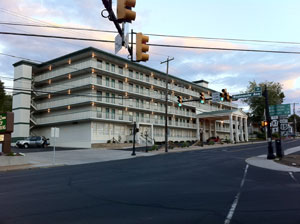 |
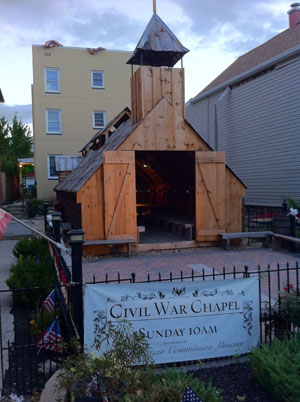 |
| The luxurious 1863 Inn | A new attraction downtown |
Friday
I was supposed to run with a friend from Gettysburg College this morning, so I ran to the North Carolina monument (about 1.9 miles from the hotel), our designated meeting point. Unfortunately, we got our calendar appointments messed up and he was not able to make it. So instead, I ran a long loop up to Oak Hill and back to the hotel, about 7 miles total. (I did not want to go crazy because I am scheduled to do a 20 mile run early next week.) I had a good breakfast at the Avenue Restaurant, just across the street from the hotel. I spent some time wandering around Cemetery Ridge, comparing unit monuments to my recent map of the area, and met up with my friend Don Wiles. Don and I had lunch with our friend Troy Harman of the National Park Service at the Spring House Tavern, downstairs at the Dobbin House restaurant. Afterward, Don and I roamed around Oak Hill, Barlow's Knoll, and the Coster Avenue mural (which is starting to degrade in the weather, sadly). We were happy to see that a number of the unit monuments just south of Oak Hill have been refreshed recently and are looking quite spiffy.
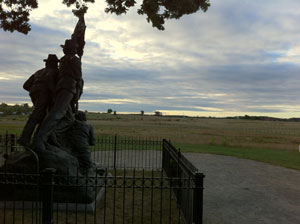 |
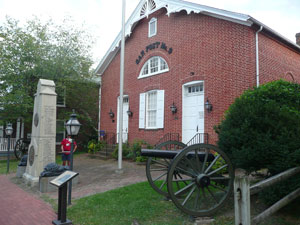 |
| Early morning at the North Carolina monument | Jack Skelly GAR Hall on Middle Street |
The ALBG program began at 6 p.m. in the GAR Hall on Middle Street. I think the official attendance was 42. This GAR post was named after Cpl. Jack Skelly, the sweetheart of Ginnie Wade. We had an informal reception and then a presentation by Col. Bill Hewitt entitled "Robert E. Lee: Command & Control Problems?" (I have been to Bill's presentations before and he frequently talks about 1863 military issues using doctrine and terminology from the modern Army, which is often pretty interesting and thought-provoking.) It was a lengthy presentation with a lot of audience give-and-take that discussed command problems on each of the three days at the battle, but Bill summed it up with three broad points: (1) Lee did not adjust to his new subordinates (after Stonewall Jackson's death of Chancellorsville), to the new demands on him (he never achieved the mass required to succeed at Gettysburg), and to the new enemy commander (Meade, who unlike his predecessors did not retreat after initial setbacks); (2) Lee did not express his vision clearly, giving Hill and Ewell unclear orders (do not bring on a general engagement—but what should they do?) and was unable to get Longstreet on the same page (attack to dislodge the Union from Cemetery Hill, don't attempt a turning movement); (3) Lee's judgment was below par on July 3.
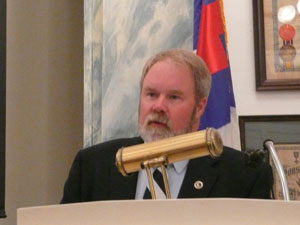 |
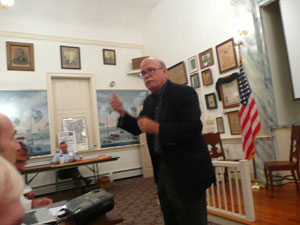 |
| Stuart Dempsey introducing the program | Col. Bill Hewitt in GAR Hall |
Saturday
We were up bright and early for a 7 a.m. breakfast buffet at the Dobbin House. Unfortunately, the restaurant got the time mixed up, thinking we were expecting 8 a.m., so we got off to a slightly late start. We boarded a school bus for the first of two presentations. Dave Richards presented "'I determined to attack ...' Gen. Robert E. Rodes and his Division on July 1." We drove out to the intersection of Biglerville Road and Herr's Ridge Road (an area known as Kegler's Hill), where Rodes made his decision about how to proceed to the battlefield, selecting a path that would take him overland south, down the spine of Oak Ridge. There was some discussion about whether it would have been more prudent to head in a more easterly direction, which would have put the division just north of Gettysburg on a road a little faster than the more rugged terrain he chose allowed. An overriding theme here was that delays on Rodes's part played a role in preventing the Confederates from taking Cemetery Hill before it was completely defended by the Union. When he reached Oak Hill, rather than attacking the assembling Union forces of Robinson's division immediately, he delayed for the arrival of all of his brigades and his artillery, missing a golden opportunity. The bus drove us to Oak Hill at the Peace Monument and we dismounted. Rodes also did not handle his attack well, allowing his brigades to diverge and spread out over the battlefield, rather than concentrating their mass on a narrow front against the Union defensive line. So this all came out rather negatively for Rodes, but Dave had a lot of good things to say about George P. Doles, one of his brigade commanders.
 |
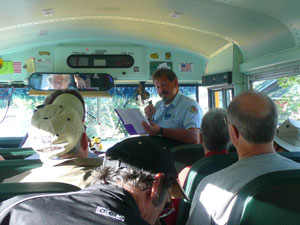 |
| The ALBG arranged for comfortable transport | Dave Richards in the bus |
Dave turned it over to Charlie Fennell, who gave a very lively presentation on the relationship between Richard S. Ewell and Robert E. Lee, "Ewell and Lee at High Tide: A Study in Command and Control." He read some amusing characterizations from Hattaway and Jones (How the North Won the Civil War) about Ewell and his birdlike tendencies. For the rest of the presentation, he kept referring to Ewell chirping away excitedly. He said that Ewell was the only general who worked for Stonewall Jackson who was neither court-martialed by him nor challenged him to a duel. And that Ewell's execution in the Gettysburg campaign prior to the battle was better than any of Jackson's work, citing Second Winchester as a perfect battle, better than Jackson's First Winchester (in which Ewell had also fought as a subordinate). Charlie portrayed Ewell as the only corps commander who actually followed the intent of Lee's orders at Gettysburg. He credited Jubal Early, one of Ewell's division commanders, with winning the first-day battle, saying that of the three major attacks, both A.P. Hill and Robert E. Rodes wasted their troops on frontal assaults, whereas Early surrounded the XI Corps and its defeat was inevitable. We of course had the mandatory discussion of Lee's ambiguous order, "[Take cemetery Hill] if practicable." Charlie seemed pretty sympathetic to Ewell, making fun of the traditional Isaac R. Trimble story about confronting Ewell ("Give me a regiment ..."). We drove over to Benner's Hill and discussed the evening assaults of July 2, and once again Charlie was pretty positive, saying that Ewell was the only corps commander to seize and hold any Union defensive position (the lower slope of Culp's Hill) during the battle. Although Robert E. Lee had nothing negative to say about Ewell in his reports, Charlie believes that Gettysburg ruined his confidence and he was never the same general.
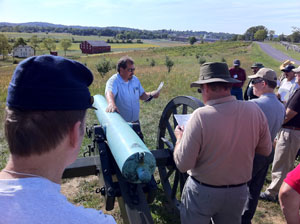 |
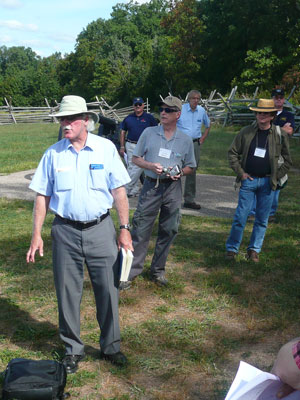 |
| Dave Richards on Oak Hill (McLean farm in distance) | Charlie Fennell on Oak Hill |
We had lunch at the Artillery Ridge Campground, a yummy selection of Subway sandwiches and accoutrements. We got to admire some of the stupendous RVs parked there—one of them was larger than a Greyhound bus and probably could have slept three or four families. Our final presentation was by Don Walters, "'The Generals Got into a Dispute about Which Should Command': Anderson's Division on July 2nd." Don is obviously a big Richard H. Anderson fan and he started out with a quotation about how Anderson was lazy, but he described how Robert E. Lee consistently promoted him during the war. He said that Lee often gave commands to Anderson directly during battles, even before he was promoted to be the fourth corps commander in 1864. The format for the talk was to follow Anderson's division physically from its crossing of a ford on Willoughby Run all the way to Cemetery Ridge. Fortunately, we had a beautiful day on the battlefield and the multi-mile walk was pretty pleasant. One of the interesting aspects was a discussion of Longstreet's countermarch, in which E.P. Alexander led the way with his artillery, a move that demonstrates the arrogance of the Confederate Army. (Normally cavalry or infantry would lead a march in enemy territory.) We made our way cross country through Pitzer's Woods, dodging numerous horse droppings—these battlefield horses must have a big lunch before they take tourists out on the trail—and crossed the Emmitsburg Road at the Spangler farm. Then we made our way up past the Codori farm and eventually stopped where the brigade of Ambrose R. Wright came close to reaching the top of Cemetery Ridge. Don was a very entertaining speaker, but I don't think that he focused very closely on the command and control aspects of the seminar theme, treating us more to a standard battlefield walk, interspersed with a tornado of trivia, including endless cousins and nephews and references to World War II destroyers named after a variety of the characters in the battle.
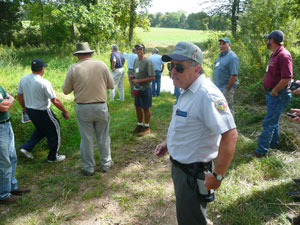 |
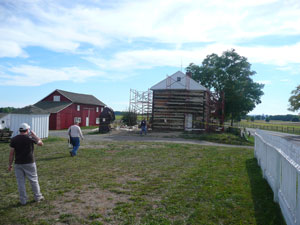 |
 |
| Don Walters at the Willoughby Run ford | Klingle House being rebuilt nearby | Tourist cavalry sharing Cemetery Ridge with us |
We drove to the Herr Tavern for drinks and dinner. The restaurant was a bit fancier than I had remembered. I saw that they have an $80 chef's tasting menu! Just like a California restaurant. Of course, we had a buffet dinner for a group this large, but the food was very good. After dinner, James Martin gave us a lengthy PowerPoint presentation on the Lost Cause movement and how some of the monuments at Gettysburg were designed to promote that ideology. Although I am pretty familiar with the Lost Cause, I had not known previously that three of the Confederate state monuments at Gettysburg were designed by the same sculptor, Don De Lue, and are known as De Lue's Triad.
Sunday
After two gorgeous weather days, today started off with a light rain, which persisted until mid-afternoon. Well, no big deal. I brought a rain slicker with me. We had another buffet breakfast at the Dobbin House and then boarded the bus for the North Carolina monument. Tony Nicastro presented "'I yield to no one ...' James Longstreet on the Second Day." I think Longstreet is one of the most interesting Confederate generals, particularly at Gettysburg. Tony wanted us to act as judge and jury on essentially two questions: Was there a sunrise-attack order on July 2, and was Longstreet unreasonably late in attacking. Unlike a courtroom, however, Tony presented just one side of the story, dismissing any criticisms. And he took almost three hours to do this. Why we started at NC is beyond me, but we soon drove down to Pitzer's Woods and stopped before the 1998 Longstreet memorial statue. I found out that the very odd proportions of his horse, Hero, was based on a plan to mount the statue overhead on a big pedestal, so the proportions might have worked out, but that plan fell through and they're on ground level, with Hero's head looking about right, but his rear half got progressively smaller. People joked that it looked like Tom Berenger on a carousel horse! We went through the timeline of the morning in great detail, including the reconnaissance by Johnson and Clark and the start of the famous countermarch. This might have been OK in nice weather, but we stood looking at that silly statue, backs to the battlefield, for well over an hour in the rain. Then we drove to Cemetery Ridge and Tony gave us a number of details about Anderson's brigades and Ewell's demonstration, entirely brushing aside any of the Longstreet command issues during the big assault.
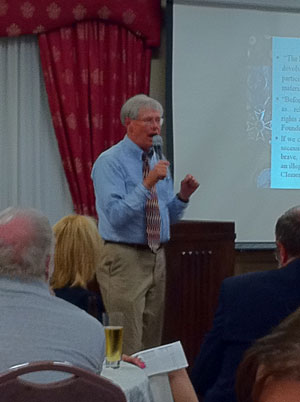 |
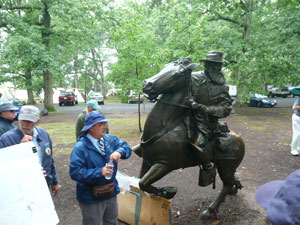 |
| James Martin at Herr Tavern | Tony Nicastro at the Longstreet memorial |
Afterward I had lunch with Don at O'Rorke's, getting a sandwich so large that I had to get one half wrapped up for my flight. We checked out the American History Store bookshop, which has an excellent selection of mostly CW books. Then, weather being what it was, I went to the park visitor center and wandered around the museum for a while. Then a quiet Sunday afternoon drive to Dulles and UAL back to SFO by 10 p.m.
All-in-all, I had a good time at the seminar, although there was a bit of grumbling about guides not keeping very close to the theme of the conference—command and control issues. Next year's seminar is September 9–11 on the Irish at Gettysburg and I'll wait to see the agenda before deciding whether to return or not. There will also be a one-day seminar in April about the struggle for Devil's Den; it is unlikely that I will attend a one-day seminar due to the travel burdens involved, but perhaps it will line up with something else.
My next trip this year is to the Mosby Heritage Area seminar on Fredericksburg, October 1-3.